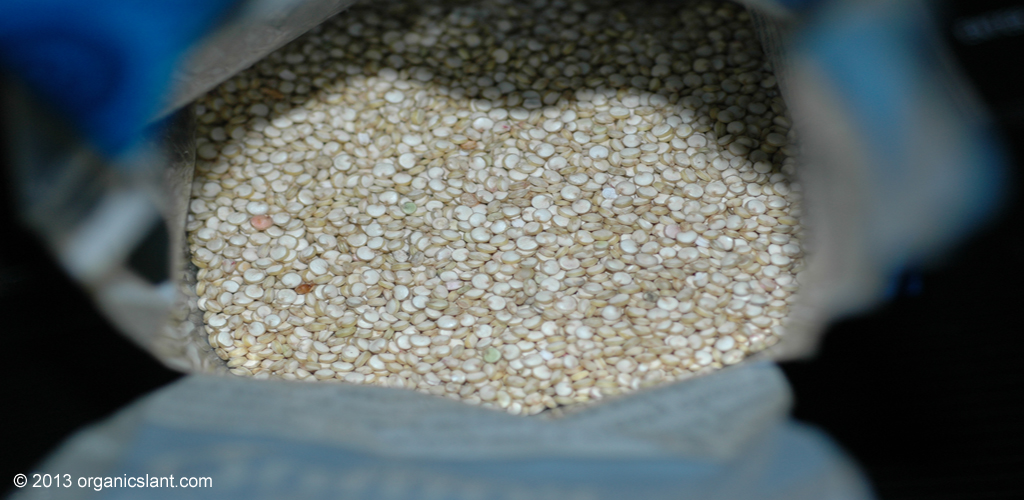Quinoa was a staple of the ancient Incas and means ‘the mother grain’. Quinoa is perhaps one of the most perfect non-animal sources of protein on the planet.
Quinoa (the name is derived from the Spanish spelling of the Quechua name kinwa or occasionally “Qin-wah”) originated in the Andean region of Ecuador, Bolivia, Colombia and Peru, where it was successfully domesticated 3,000 to 4,000 years ago for human consumption, though archeological evidence shows a non-domesticated association with pastoral herding some 5,200 to 7,000 years ago
What makes quinoa (pronounce keen-wah) unique is that it is the only plant based source of complete protein. “Complete” means that it contains all 9 of the essential amino acids that are crucial to human function and health.
After harvest, the seeds need to be processed to remove the coating containing the bitter-tasting saponins. Quinoa seeds are in general cooked the same way as rice and can be used in a wide range of dishes. Most quinoa sold commercially in North America has been processed to remove this coating. If not, it should be rinsed thoroughly by using a strainer or by running fresh water over the quinoa for 3 minutes.
Quinoa is considered a superfood. Protein content is very high (14% by mass), yet not as high as most beans and legumes. Nutritional evaluations of quinoa indicate that it is a source of complete protein. Furthermore, it is a good source of dietary fiber and phosphorus and is high in magnesium and iron. Quinoa is also a source of calcium, and thus is useful for vegans and those who are lactose intolerant. Quinoa is gluten-free and considered easy to digest.
Quinoa is also rich in lysine. Lysine is one of the essential amino acids of the nine, and it plays an important role in the absorption of calcium and the formation of collagen. It is also a food that is on the low end of the glycemic index.
Benefits
- Complete amino acids. Your body requires nine essential amino acids to build muscle and body tissue: histidine, isoleucine, leucine, lysine, methionine, phenylalanine, threonine, tryptophan and valine. Quinoa is one of the few foods that contains all nine.
- Ample protein. Because quinoa is so rich in amino acids, it is a very good source of protein, particularly for vegetarians. One serving can have as much as 20% protein, about 50% more than wheat and more than 2.45 times that of rice.
- Oxygen-carrying iron. In your body, iron plays a vital role, helping to deliver much-needed oxygen to your cells. Iron-rich quinoa supplements iron levels in your body, helping you avoid anaemia and improving oxygenation of the brain and your extremities.
- Large dose of fibre. Quinoa has double the fibre found in most grains, so it will help keep you regular. Fibre has also been clinically shown to reduce cholesterol levels and help those with diabetes control their blood glucose levels.
- Age-fighting manganese. A powerful antioxidant, manganese helps to protect your body from free radicals, particles in the environment that cause cellular damage. Studies have found that a diet rich in antioxidants can protect the heart, decrease one’s risk of cancer and slow down the appearance of wrinkles.
Use basic quinoa in any favorite rice or grain recipe. Place 1 cup of dry quinoa and 2 cups of water in a saucepan to boil. Reduce heat and simmer until water is absorbed (10 to 15 minutes). When done, the grains will be translucent and the outer germ layer will separate.
Quinoa is wonderful when paired with lightly steamed vegatables, and a bit of Pink Himalayan sea salt.

 Animal vs. Plant Protein: These Protein Sources Are Not Nutritionally Equivalent
Animal vs. Plant Protein: These Protein Sources Are Not Nutritionally Equivalent Human cells take in less protein from a plant-based ‘meat’ than from chicken
Human cells take in less protein from a plant-based ‘meat’ than from chicken Green tea and iron, bad combination
Green tea and iron, bad combination Food protein can eliminate pungency and bitterness of extra virgin olive oil
Food protein can eliminate pungency and bitterness of extra virgin olive oil